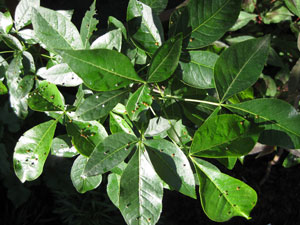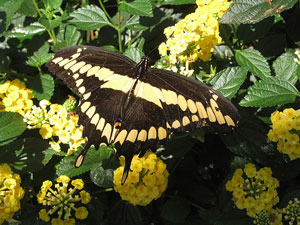Resource Library
Plant of the Week: Wafer Ash (Hop Tree)
The University of Arkansas System Division of Agriculture does not promote, support or recommend plants featured in "Plant of the Week." Please consult your local Extension office for plants suitable for your region.
Plant of the Week
Wafer Ash or Hop Tree
Latin: Ptelea trifoliata

Here at the Botanical Garden of the Ozarks we have a minor emergency on our hands in the butterfly house. Too many caterpillars and one very small bush on which they will feed. The small bush in question is the Wafer Ash or Hop Tree (Ptelea trifoliata), the principle host to the giant swallowtail butterfly.
Wafer ash is a large shrub or small deciduous tree native across a wide swath of North America from Canada to northern Mexico and including all of the eastern and southwestern states. The shrub belongs to the citrus family and represents the most cold-hardy member of the family.
Our species are recognized by the USDA with all being native to North America. Though the species has a very wide distribution even here in Arkansas, it is an unfamiliar shrub to most people because it occurs in widely scattered stands and is relatively nondescript as shrubs go. In a lifetime of tromping in the woods I have only encountered it twice in the wild.
Ptelea -- the “P” is silent -- grows 15 to 18 feet tall with a lot of low branching so the shrub or small tree is often wider than tall. It is slow growing and has bright green trifoliate leaves with leaflets 2 to 4 inches long. The 5 year old shrub in our Ozark Native Plant Garden is just now five feet tall and is flowering for the first time this year. Young leaves, if crushed, have a faint citrus smell but older leaves – at least according to one author – are more reminiscent of skunk. In the fall leaves take on a yellow-green fall color.
The tiny greenish-white, not-especially-showy flowers are produced in a 2- to 3-inch wide terminal panicle in late spring after the leaves have appeared. Some report a citrus fragrance to the blooms but I have not noticed it on our shrub. The flowers give rise to a penny size and shaped flat wafer that looks much like the samara of an elm, only larger. The Latin name was assigned by Linnaeus and is the name the Greeks used for elms. The fruit ripen in late summer and persist into the winter after the foliage has fallen. Though interesting, it is a stretch to call the fruit attractive.

This species is called the hop tree because early American brewers used the bitter fruit as a poor substitute for hops when brewing beer. Native Americans were said to make a poison for arrow tips from the bark. Steyermark, in his classic Flora of Missouri, reports it was once called ague bark because a treatment for malaria was extracted from the bark of the tree. But today, what few native plant enthusiasts grow it, do so because it is the favored host of the giant swallowtail butterfly.
Wafer ash is actually a handsome, shiny-leafed shrub that should be used more commonly in gardens and shrub borders than it is. It grows equally well in full sun or shade and is tolerant of a wide array of soil types. In the Ozarks I have found it at the edge of clearings in good, moderately moist soils but not next to streams. Once established, Ptelea has considerable drought tolerance as indicated by its wide distribution in our western states. A gold-leafed selection called ‘Aurea’ is listed and, though the foliage fades to green as the summer progresses, should be an interesting addition to the garden.
Though our small wafer ash will soon be riddled by the ugly, pinkie sized caterpillars of the giant swallowtail I’m hopeful they will move over to a nearby rue, an alternative host also in the citrus family. If not, we’ll hand feed the larvae leaves from our outside plant until they finish their growth spurt.
By: Gerald Klingaman, retired
Retired Extension Horticulturist - Ornamentals
Extension News - June 1, 2012
The University of Arkansas System Division of Agriculture does not maintain lists of retail outlets where these plants can be purchased. Please check your local nursery or other retail outlets to ask about the availability of these plants for your growing area.